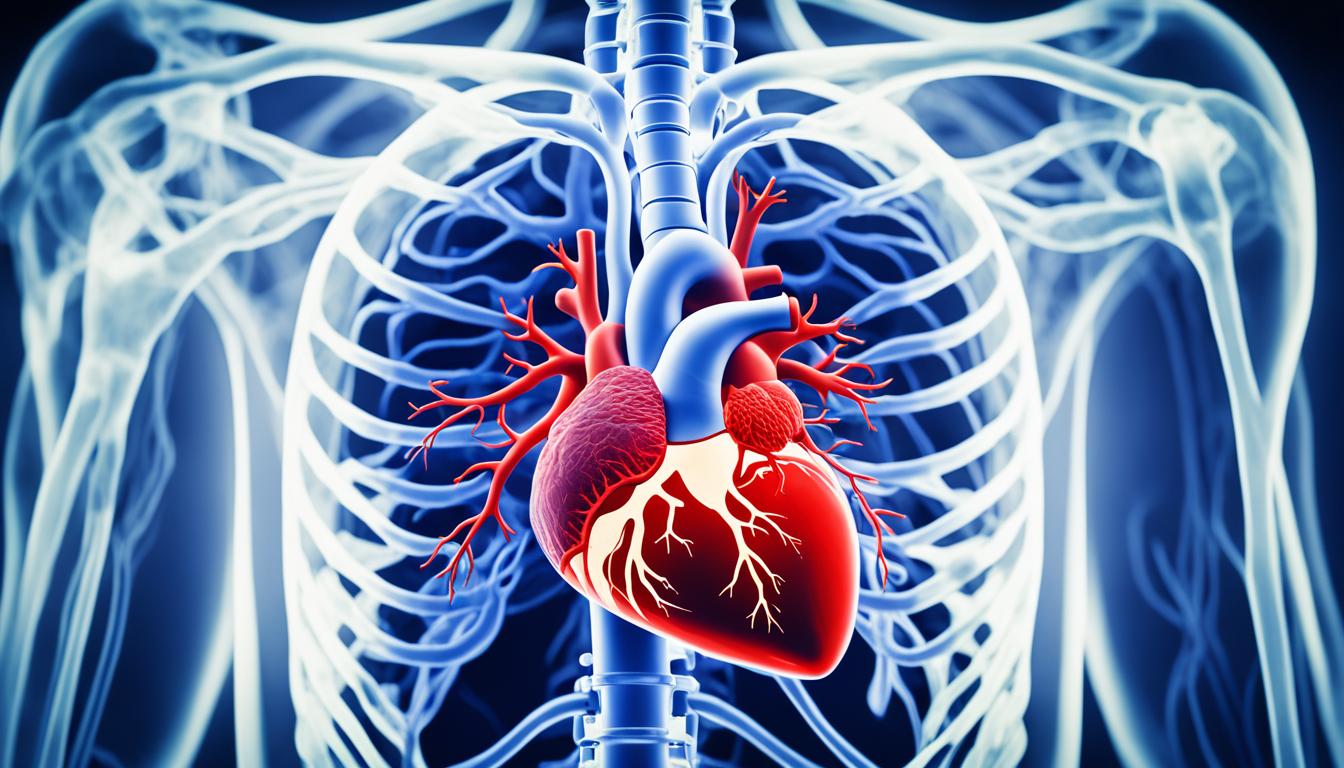Regurgitation aortic valve disease makes blood leak back into the heart’s left ventricle. It comes from the aorta. This can cause symptoms and complications, making someone’s health worse.
The disease’s symptoms are shortness of breath, tiredness, and chest pain. These can make daily life hard and reduce its quality.
It can happen for many reasons. Some are from birth, others come from infections that damage heart valves. Illnesses like rheumatic fever and aging of the valves can also play a part.
To diagnose this, doctors use medical imaging like echocardiography. These tests show how bad the leak is. They help make a plan for treatment.
Stem cell therapy is a new way to treat this disease. It can fix or replace damaged parts of the heart with stem cells. This could lead to better heart function and health.
Key Takeaways:
- Regurgitation aortic valve disease lets blood leak into the heart’s left ventricle.
- Its common symptoms are shortness of breath, tiredness, and chest pain.
- It might be caused by birth defects, infections, rheumatic fever, or aging valves.
- Echocardiography is used for diagnosis.
- Stem cell therapy is promising for treatment by fixing heart damage.
Prevalence and Impact of Aortic Valve Regurgitation
Aortic valve regurgitation is a common heart problem. It means that the aortic valve doesn’t close fully. So, blood leaks back into the heart. This makes the heart work harder.
About 6 to 13 out of every 1000 babies have this issue. It shows how often it happens. And if not treated, it can lead to serious problems.
This problem can lead to heart failure. The heart can’t pump blood well. It causes shortness of breath, tiredness, and swelling. It also makes healthcare more expensive because of checks and possible surgeries.
Finding and treating aortic valve regurgitation early is key. Regular heart checks with a doctor are important. They can spot the issue before it gets worse. This helps in preventing heart damage and keeps the heart’s valves healthy.
Refer to the table below for more on how often aortic valve regurgitation happens and its effects:
| Population Group | Prevalence of Aortic Valve Regurgitation |
|---|---|
| Babies per 1000 live births | 6 to 13 |
| Adults | Varies based on age and risk factors |
| Elderly | Common due to wear and tear on valves |
Early finding and the right treatment can improve life for those with this issue. Regular heart checks and a healthy lifestyle are important. They reduce the risk of problems.
Causes and Risk Factors of Aortic Valve Regurgitation
The aortic valve can leak for many reasons. Some people are born with heart valve issues. Others may get them over time, such as from too much calcium or from cholesterol building up. Rheumatic fever or just getting older can also harm the valve.
When born with a heart valve that’s not quite right, it might not let blood flow properly. As people age, their heart valves can also harden and start to leak. Rheumatic fever is a sickness caused by an untreated throat infection. It can mess up the heart valve, leading to leaking.
Family history and high blood pressure might make aortic valve problems more likely. Smoking, being overweight, or obese are also bad for your heart. These can all increase the danger of getting aortic valve regurgitation.
The Role of Maintaining Heart Valve Health
Lifestyle choices like eating well and staying active can keep your heart in good shape. Not smoking and staying at a healthy weight is important too. These choices lower the chances of having a leaky heart valve.
Getting regular check-ups and managing your blood pressure is smart. If a heart issue is found early, it’s easier to treat. This includes taking care of illnesses like rheumatic fever, which can harm the heart valve.
Knowing what causes heart valve problems helps you protect your heart. Making the right choices can keep your heart valve health in check.
Stem Cell Therapy for Aortic Valve Regurgitation
Now, stem cell therapy is showing a lot of promise for treating aortic valve regurgitation. This is a heart condition where blood flows the wrong way, back into the heart’s left ventricle. The goal of this new method is to fix or swap out the damaged parts of the heart. It aims to offer solutions that can last a long time, using the body’s own healing.
Scientists are looking at several kinds of stem cells for this, such as from bone marrow, fat tissue, and embryos. These special cells can become many different types of cells. This makes them great for rebuilding parts of the heart.
When combined with support from biomaterial scaffolds, stem cell therapy could be a big step towards fixing heart valves. These scaffolds act as a base for the stem cells to grow and change into the needed tissues. They help repair and rebuild heart tissue in a good environment.
There’s a lot of ongoing research and tests happening to check if this therapy is safe and works well for aortic valve regurgitation. With new progress in stem cell science and biomaterials, there’s hope for better ways to treat heart valve problems. This brings optimism for people dealing with these issues.

